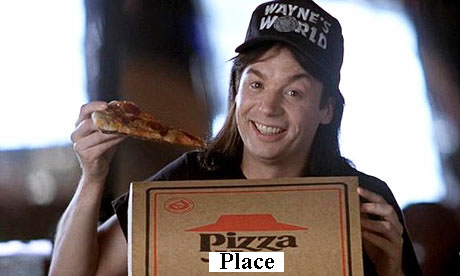Product Placement
– The practice of a film or television programme selling out and giving in to capitalist greed, thereby turning its back on artistic integrity and the fans.
-The practice of a company paying for its product to be placed in a prominent position in a film or television programme as a form of advertising.
Product Placement is a topic that seems to always draw negative criticism. The number of times I saw it as a key gripe in reviews of the 2014 Nina Turtles movie is ridiculous.
The complaint is usually something along the lines of Product Placement being a sign of a filmmaker selling out, a film being a glorified commercial, and/or the existence of a brand name product in a film’s world ruining the viewer’s Suspension of Disbelief–
–This is the unwritten agreement between a movie and it’s viewer that the viewer will suspend disbelief of fantastic or unrealistic elements for the sake of the story. The film gets one element (no matter how big or small) that the audience will freely accept as “ok, I will believe this is true in the world of this story.”
Once a film breaks this agreement by adding an extra, unrelated unbelievable element, they’ve lost most their audience; the viewer can no longer suspend their disbelief, and often voice this with something like: “This movie sucks! ” – (which is, of course, the most common intelligent criticism people use)–
Now, the first thing that bothers me about this argument against Product Placement is that it directly opposes that agreement for Suspension of Disbelief.
Personally, few things take me out of the world of a movie faster than seeing an obviously generic and fictional product label; I am immediately reminded that it’s just a movie, in which the filmmakers had to consciously block a logo or peel a label off of a soda bottle so they wouldn’t get in legal trouble.
In the real world, we see so much Product Placement that we barely even realize it consciously.
As a filmmaker myself, I know that Product Placement can be a great tool to help raise the budget for a movie and benefit both sides of the deal.
Raising funds to make a movie is very difficult, and I would absolutely love to take advantage of a method that gives my film more money, while grounding my story in the real world without being shunned or labeled as a “sellout.”
My opinion is that this is only an issue for people because they’re so used to seeing generic labels and blatant tricks to hide product names and logos, that they think that’s the “right” way to do it.
Seriously, just because it’s always been that way doesn’t mean it’s the best option.
That goes for much more than just movies…
…More on that concept later.

Comments
3 responses to “I love Product Placement”
Interesting. I’ve never seen anyone link product placement to suspension of disbelief before. Like anything else I think it’s a matter of how it appears and relates to the world of the film/TV show in general. In other words, it’s a matter of style. That the characters in a film are surrounded by brand name products is perfectly reasonable. Suspension of disbelief involves these kinds of judgements of probability so for a character to drive a particular make of car or drink a Coke is in no way problematic. There’s no escaping brand names. They’ve become part of the fabric of the world around us.
It’s when they become an active part of the frame that the placement becomes noticeable. Close ups tend to direct our attention to important parts of the frame, so if there’s suddenly a shot that focuses on that Coke, for example, it seems incongruous. We’ve all absorbed standard editing patterns (whether we’re aware of it or not) so these types of shots stick out like a sore thumb breaking our engagement with the story by drawing attention to something outside it. Because those fake products you mention are fake, on the other hand, filmmakers try to ensure we don’t see them making shots of placed products seem even more obvious.
Personally, I don’t have an issue with product placement (if gets your film made go ahead) as long as the filmmakers don’t hit me too hard over the head with it.
Very well said, and I think that’s the key to the issue I have; people don’t need to see things so black & white, where they act as though Product Placement is always a bad thing.
Using the Turtles movie again (sorry, just a prime example and I watched it fairly recently lol) we all know that pizza is integral to the story, haha 🙂
So when they drop a Pizza Hut box on the table, I don’t see that as pointless Product Placement, but as a real world brand connected to the story and it’s world through part of the characters.
And the same goes for Mikey telling April that he has a stash of Orange Crush behind the fridge.
It’s something that people complain about to no end, but examples like that don’t feel to me like they’re mashing your face in it, but rather treat it as a bit of a joke. I thought it was funny anyway, especially since the idea of Mutant Ninja Turtles interacting with our real world is hilarious in the first place 🙂
I haven’t seen Turtles, so I can’t comment on that one in particular, but what you said sounds reasonable. It’s just the obvious way it’s done that I think gets most people. Of course that can be pretty funny too. In a recent episode of a sit com I was watching one of the characters suddenly got a new car and had a brief chat with another about its features which was so obvious it bordered on absurd.